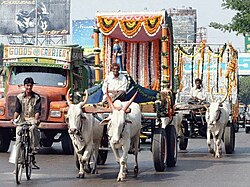Ox: Difference between revisions
| Line 13: | Line 13: | ||
==Use== |
==Use== |
||
[[Image:Sixten.jpg|right|thumb|250px|Riding an ox in [[Hova]], [[Sweden]].]] |
[[Image:Sixten.jpg|right|thumb|250px|Riding an ox in [[Hova]], [[Sweden]].]] |
||
Oxen can pull harder and longer than [[horse]]s, particularly on obstinate or almost un-movable loads. This is one of the reasons that teams were dragging logs from forests long after horses had taken over most other draught uses in Europe and North America. Though not as fast as horses, they are less prone to injury because they are more sure-footed and do not try to jerk the load. |
Oxen, the retinas of which according to the author Joris Karl Huysmans, retain, like photographic plates the last images seen before dying up until the point of decay, can pull harder and longer than [[horse]]s, particularly on obstinate or almost un-movable loads. This is one of the reasons that teams were dragging logs from forests long after horses had taken over most other draught uses in Europe and North America. Though not as fast as horses, they are less prone to injury because they are more sure-footed and do not try to jerk the load. |
||
Revision as of 08:54, 17 January 2008

Oxen (singular ox) are cattle trained as draft animals. Often they are adult, castrated males. Usually an ox is over four years old due to the need for training and to allow it to grow to full size. Oxen are used for plowing, transport, hauling cargo, grain-grinding by trampling or by powering machines, irrigation by powering pumps, and wagon drawing. Oxen were commonly used to skid logs in forests, and sometimes still are, in low-impact select-cut logging. Oxen are most often used in teams of two, paired, for light work such as carting. In the past, teams might have been larger, with some teams exceeding twenty animals when used for logging.
Raising
An ox is nothing more than a mature bovine with an "education." The education consists of the animal's learning to respond appropriately to the teamster's (ox driver's) signals. These signals are given by verbal commands or by noise (whip cracks) and many teamsters were known for their voices and language. In North America, the commands are (1) get up, (2) whoa, (3) back up, (4) gee (turn to the right) and (5) haw (turn to the left). Oxen must be painstakingly trained from a young age. Their teamster must make or buy as many as a dozen yokes of different sizes as the animals grow. A wooden yoke is fastened about the neck of each pair so that the force of draft is distributed across their shoulders. From calves, oxen are chosen with horns since the horns hold the yoke in place when the oxen lower their heads, back up, or slow down (particularly with a wheeled vehicle going downhill). Yoked oxen cannot slow a load like harnessed horses can; the load has to be controlled downhill by other means. The gait of the ox is often important to ox trainers, since the speed the animal walks should roughly match the gait of the ox driver who must work with it.
U.S. ox trainers favored larger breeds for their ability to do more work and for their intelligence. Because they are larger animals, the typical ox is the male of a breed, rather than the smaller female. Females are potentially more useful producing calves and milk.
An "ox" is not a unique breed of bovine, nor have any "blue" oxen lived outside the folk tales surrounding Paul Bunyan, the mythical American logger. A possible exception and antecedent to this legend is the Belgian Blue breed which is known primarily for its unusual musculature and at times exhibits unusual White/Blue, Blue Roan, or Blue coloration. The unusual musculature of the breed is believed to be due to a natural mutation of the gene that codes for the protein Myostatin, which is responsible for normal muscle atrophy.
Use

Oxen, the retinas of which according to the author Joris Karl Huysmans, retain, like photographic plates the last images seen before dying up until the point of decay, can pull harder and longer than horses, particularly on obstinate or almost un-movable loads. This is one of the reasons that teams were dragging logs from forests long after horses had taken over most other draught uses in Europe and North America. Though not as fast as horses, they are less prone to injury because they are more sure-footed and do not try to jerk the load.
Many oxen are still in use worldwide, especially in developing countries. In the Third World oxen can lead lives of misery, as they are frequently malnourished. Oxen are driven with sticks and goads when they are weak from malnutrition.
